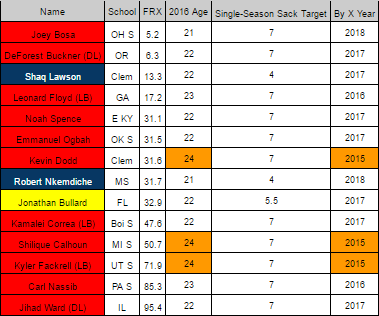Force Players is an athletic threshold based off of combine performances of pass-rushers that I’ve been working on since 2011. It isn’t the end all be all for edge defenders, but it’s close. It works as a healthy risk analysis, based on a sample of the 2005 through 2015 draft classes.
I often get asked if Player X is a Force Player or not, so I decided to make a definitive list for the coming 2016 season, now that the draft is over. I included the the Prodigy status of individual pass-rushers and what their peak sack average is, taken from Force Players: Sack Study.
We can say that there’s a fairly definitive line for success for pass-rushers who are X athletic with X production at X age.
The trend is pretty simple, In just about every case, Force Players double non-Force Players in sack output of their best three seasons when split by round. Judging by the number of active players in each category and the success of pass-rushers from the 2015 and 2014 draft classes, the numbers should only rise over the next few years.
Notes:
- Players who are 23-year-olds or younger were highlighted in the “Age” column.
- Players who have posted fewer than three seasons in the NFL were highlighted in the “Average” column.
- Players who began their NFL careers at the age of 24 or older were automatically placed in the non-Prodigy categories, but have been noted with “No-Age” in the “Prodigy Pass” column.
If this trend keeps up to the standard of the last decade or so, the players in make or break seasons are:
- Force Players: Frank Clark (Seattle), Randy Gregory (Dallas), Shaq Riddick (Arizona) and Trevor Bates (Indianapolis)
- Mid Tiers: Bud Dupree (Pittsburgh) and Stephen Weatherly (Minnesota)
Force Players need to hit a four-sack single-season mark before they begin a regular season as 24-year-olds before they’re on track for success, while Mid Tiers need to hit a 5.5-sack single-season mark.
Here are players who have similar athleticism when compared to best pass-rushers in the league, but are 22 years old or younger:
- Force Players: Shaq Lawson (Buffalo), Robert Nkemdiche (Arizona), Danielle Hunter (Minnesota-already passed Prodigy filter), Dean Lowry (Green Bay) and Tyrone Holmes (Jacksonville)
- Mid Tiers: Jonathan Bullard (Chicago)
One player, Bronson Kaufusi, is over the age of 23, and begins his rookie season with elite athleticism.
]]>Based on athletic potential, you can tell a lot about pass-rushing prospects.
Force Players is an athletic threshold based off of combine performances of pass-rushers that I’ve been working on since 2011. It isn’t the end all be all for edge defenders, but it’s close. It works as a healthy risk analysis, based on a sample of the 2005 through 2015 draft classes.
Using Force Players to split up different categories of pass-rushers, you’ll find that athletic draft prospects selected early in the draft are about twice as productive at their peaks as their counterparts.
The trend is pretty simple, In just about every case, Force Players double non-Force Players in sack output of their best three seasons when split by round. Judging by the number of active players in each category and the success of pass-rushers from the 2015 and 2014 draft classes, the numbers should only rise over the next few years.
Using Force Players to split up different categories of pass-rushers, you’ll find that athletic draft choices selected early in the draft are eight times more likely to still be on their original team by their sixth year in the NFL (equivalent to seeing a second contract after a fifth-year option for this generation’s first-round picks.)
7.1 percent of those non-Force Players were still with their original franchise during their sixth NFL season. You’re 8.32 times more likely to still be on your original franchise in your sixth season in the league if you’re a first- or second-round Force Player compared to a non-Force Player.
You can also essentially pin down if a pass-rusher is or isn’t go to “make it” in the league by his productivity relative to his athleticism at the age of 23.
We can say that there’s a fairly definitive line for success for pass-rushers who are X athletic with X production at X age.
So how does that help us view this draft class? Specifically looking at the 2016 pool, using first-round numbers alone (since 2005), we can claim that:
- There’s a 61 percent chance that Shaq Lawson is going to average around 13 sacks in his three best seasons in the statistic (about Shawne Merriman or Clay Matthews), while there’s a 39 percent chance that he’s going to average around 4.5 sacks in his three best seasons (about Manny Lawson.)
- There’s a 82 percent chance that Joey Bosa and Leonard Floyd are going to average around three sacks in their three best seasons in the statistic (about Derrick Harvey), while there’s an 18 percent chance that they’re going to average around 11 sacks in their three best seasons (about Chandler Jones.)
- Leonard Floyd, who is turning 24 years old before Week 1, should have been producing in the NFL at a seven-sack rate last season to be conducive to next level success, but he was instead playing as an off the ball linebacker in college football in 2015.
As pure pass-rushers, there odds seem to be against San Diego’s Joey Bosa and Chicago’s Leonard Floyd, but in favor of Buffalo’s Shaq Lawson.

Force Players is an athletic threshold based off of combine performances of pass-rushers that I’ve been working on since 2011. It isn’t the end all be all for edge defenders, but it’s close. It works as a healthy risk analysis, based on a sample of the 2005 through 2015 draft classes.
I began a study to try to test if those who lack Force Player athleticism at 21 years old, like Joey Bosa, have a significantly higher “hit” rate than those who failed to reach the threshold at 22 or 23, and the results were inconclusive. What I was able to stumble into, though, was that you can tell how good a pass-rusher is going to be based on what their highest single-sack mark is at the age of 23 and what their athletic background is.
Sample set:
- 2005-2015 first- through third-round picks
- Force Players, Mid Tiers and non-Force Players
- Peak Average: best three sack totals averaged from Force Players: Sack Study
What was interesting to me is that Force Players, Mid Tiers and non-Force Players seem to have three different thresholds. For the purpose of simplifying an idea into one word, we’ll call those who pass the thresholds “Prodigies.” It was the first Google result for “What’s the opposite of a late-bloomer?”
- Force Players: 4 sacks
- Mid Tiers: 5.5 sacks
- non-Force Players: 7 sacks
This study was done by judging players’ age by how old they were on September 1 of a given year.
So, if a Force Player had four or more sacks during a season in which he began Week 1 as a 23-year-old or younger, then he passes. The same can be said of a Mid Tier with 5.5 sacks or a non-Force Player with seven sacks. Simple?
Here are the results by athletic category.
Force Players:

Mid Tiers:

non-Force Players:

Here’s a visualization of every category combined, with the Prodigies highlighted in blue and the non-Prodigies highlighted in orange:

Notes on this:
- Charles Johnson and Justin Tuck had breakout season at 24 years old, but Tuck missed double-digit games in the season he began as a 23-year-old.
- Some of the top non-Prodigies were late-blooming Force Players like Jerry Hughes, Anthony Spence, Jason Worilds and Melvin Ingram.
- Paul Kruger was able to put together two nice seasons, with one coming off the bench in Baltimore. Michael Johnson, Jason Hatcher, and Robert Ayers, the three non-Force Player non-Prodigies following him, are largely products of one splash season among average careers.
- Adrian Clayborn (5.33) is the only Force Player Prodigy to net fewer than a 10.17 Peak Average. He missed the majority of his second and fourth seasons in the league due to injury after his 7.5-sack rookie season.
So what does this mean?
- It doesn’t look good for prospects who come into the league as 24-year-olds. We should already have a sample of how good they are, and the fact that they were still playing in college as 23-year-olds is concerning.
- For rookies who will start their careers at 23 years old, we should know right away if they will or won’t make an impact at the next level.
- We can say that there’s a fairly definitive line for success for pass-rushers who are X athletic with X production at X age.
The following table is a list of players who either just completed the season at 23 years old or have already passed through the filter at a younger age, but all have spent less than three seasons in the league. On the far right is the projected sum of a pass-rusher’s top three seasons, based on Prodigy status and athletic category. It’s simply the Mean Peak Average of similar edge defenders multiplied by three and rounded.

Numbers would suggest to buy stock in Vic Beasley, despite the backlash on him, and DeMarcus Lawrence, despite his athletic background. Preston Smith and Danielle Hunter led rookies in sacks off of the bench last season, and in a weak pass-rushing draft class, teams would be smart to see about potentially trading for one of them.
Here are the edge defenders who have yet to play a season at 23 years old, and have yet to hit the threshold set by Prodigy.

For all but Dante Fowler and Mario Edwards, who entered the league as 21-year-olds last season, 2016 will be a make or break season for the group.
Here’s a look at the 2016 draft class. FRX is essentially the over-under of when a player will be drafted based off of the current numbers on Play the Draft, which I find to be a decent measure of draft stock. These are the first- through third-round “DE” prospects on their site, along with some other players I believe can be edge rushers.
Age is based on how old a player will be on September 1 of this year, but it should be noted that Leonard Floyd will turn 24 on September 8, the very day the NFL season kicks off. He’s beginning his professional career as a 24-year-old. Ages came from Dane Brugler’s 2016 Draft Guide, which is well worth the $6.99 you can buy it for. It has been my go-to guide for the past three or four years.

So, in terms of make or break seasons, the fates of Floyd (a very old 23) and Carl Nassib should be sealed by the end of their rookie campaigns.
]]>Force Players is an athletic threshold based off of combine performances of pass-rushers that I’ve been working on since 2011. It isn’t the end all be all for edge defenders, but it’s close. It works as a healthy risk analysis, based on a sample of the 2005 through 2015 draft classes.
After running a study on the retention rate of pass-rushers based on combine athleticism, I decided to look at what “peak sack” of Force Players are compared to non-Force Players.
Here are the raw facts:
- Based on pass-rushers from the 2005-2013 classes, first-round Force Players average 9.14 sacks a season for their three best sack totals. First-round non-Force Players only average 4.49 sacks in their prime. Of the 16 non-Force Players drafted in the first round, only two, Aldon Smith and Chandler Jones, even crossed the 9.14-sack mark over a three-year span. A first-round Force Player has a 50 percent chance to average 10 sacks or more for his three best sack totals, while that number for non-Force Players is 12.5 percent, one fourth of a Force Player’s chances. Eight of the 11 Force Players who haven’t reached a three-year 10-sack peak are still on a roster, meaning 72.7 percent of those hitting under the mark still have a chance to improve their scores. Only four of the 14 non-Force Players who hit under the mark are still in the NFL, a 28.6 percent number, about two fifths of where the Force Players hit.
- Second-round Force Players average 6.47 sacks a season for their three best sack totals. First-round non-Force Players only average 3.04 sacks in their prime. Of the 19 non-Force Players drafted in the second round, only two, Paul Kruger and Jabaal Sheard, even crossed the 6.47-sack mark over a three-year span. A first-round Force Player has a 33.3 percent chance to average 10 sacks or more for his three best sack totals, while that number for non-Force Players is 0 percent. Of the four Force Players who didn’t reach a three-year 10-sack peak, Jason Worilds retired in his prime, and Brooks Reed and Jamie Collins are still on a roster. Other than Kruger and Sheard, only three of the remaining 17 non-Force Players are still in the NFL, good for 17.6 percent.
The trend is pretty simple, In just about every case, Force Players double non-Force Players in sack output of their best three seasons when split by round. Judging by the number of active players in each category and the success of pass-rushers from the 2015 and 2014 draft classes, the numbers should only rise over the next few years.
- First-round Force Players: 9.14 sacks
- First-round non-Force Players: 4.49 sacks (49.1 percent of FP)
- Second-round Force Players: 6.47 sacks
- Second-round non-Force Players: 3.04 sacks (47.0 percent of FP)
- Third-round Force Players: 8.42 sacks
- Third-round non-Force Players: 3.72 sacks (44.2 percent of FP)
- Fourth-round Force Players: 3.52 sacks
- Fourth-round non-Force Players: 1.63 sacks (46.3 percent of FP)
Force Players is an athletic threshold based off of combine performances of pass-rushers that I’ve been working on since 2011. It isn’t the end all be all for edge defenders, but it’s close. It works as a healthy risk analysis, based on a sample of the 2005 through 2015 draft classes.
It’s heavily based around the three-cone drill and both the vertical and broad jumps. The short shuttle and the 10-yard split from the 40-yard dash are weighted more than the 40-yard dash itself. Looking at these numbers, it’s pretty obvious that the least important drill is the one which gets the most publicity.
2016 Force Players (Interior Defensive Linemen)
Force Players is a risk analysis used for edge defenders, but if I were forced to translate it to the interior defensive line, which I get questions about weekly, it would be more of a highlighting function for one-gap defensive linemen. Below is a look at the active 2005-2014 Force Player (blue) and Mid Tier (yellow) interior defensive linemen who were drafted in the first two rounds of the NFL draft.
There doesn’t seem to be any relationship between the difference of Force Players and Mid Tiers on the interior defensive line. This makes sense, as I’ve stated the difference between the two in edge defender evaluation is start-stop-start ability, which doesn’t really exist on the interior defensive line. On the inside, you need to burst out of your stance and go. There is no stop.
Edge defenders
Force Players: Shaq Lawson (Clemson)
Mid Tiers: None
Interior defensive linemen
Force Players: Connor Wujciak (Boston College), Maliek Collins (Nebraska)
Mid Tiers: Chris Jones (Mississippi State), Javon Hargrave (South Carolina State), Sheldon Rankins (Louisville), Vincent Valentine (Nebraska)
Somewhere in the middle
Force Players: Bronson Kaufusi (BYU), Dean Lowry (Northwestern)
Mid Tiers: Jonathan Bullard (Florida)
Robert Nkemdiche (Mississippi) is either a Mid Tier or Force Player depending on what his short shuttle looks like. It has been reported other places, but since I built my data on however NFLDraftScout.com processes their pro day information, I’m going to wait until they post the results to run it through the formula. I’ll have a pro day update some point before the draft.
Other significant players who are possible Force Players based on their partial combine results: Charles Tapper (Oklahoma), Stephen Weatherly (Vanderbilt), Chris Mayes (Georgia), Kenny Clark (UCLA) and Kyler Fackrell (Utah State).
]]>I will say, though, the combines of Bosa and his former teammate Noah Spence concern me. NFL Network’s Charley Casserly, who was the general manager of the Washington Redskins from 1989 to 1999, stated that Bosa was better than Ezekiel Ansah, who if you are judging by Pro Football Reference’s Adjusted Value, has the sixth-most efficient career of a first-round pass-rusher since 2005. The only names ahead of him are J.J. Watt, who Bosa has also been compared to, Von Miller, Clay Matthews, DeMarcus Ware and Khalil Mack.
The topic of Bosa reaching an eight-sack rookie season came up, something only 17 players have been able to do since 2005, including Ansah. Of the 17 players, nine were Force Players, including the only two interior defensive linemen on the list, three were Mid Tiers, two were non-Force Players and three hovered in no man’s land without full data on hand. Shawne Merriman would have qualified as either a Force Player or a Mid Tier pass-rusher, but we can’t pin him down into one category. Tamba Hali and Elvis Dumervil didn’t post enough data to even narrow them down that far.
@afc2nfc I think it's possible, but that list is real short. I don't think it's likely. pic.twitter.com/1150CI6UKB
— Justis Mosqueda (@JuMosq) April 6, 2016
My point was this, though: Only two of the 17 players who were able to accomplish this goal were non-Force Players, which in my mind is a red flag for Bosa’s chances, as the majority of pass-rushers drafted are non-Force Players. Even then, one, Aldon Smith, was coming off of a visible injury during his final year in college, which I speculate may have muddied his combine numbers.
What stuck me odd when I was compiling the data set was the fact that both of the non-Force Players weren’t on the rosters of the original teams which drafted them. If I were to make a list of first- and second-round misses who the Force Players filter passed over, Smith and Sheard are two of the first three. In terms of Approximate Value/Season, Chandler Jones and Sheard lead the list of non-Force Players, with Smith’s recent efforts holding him down in the seventh spot.
The other non-Force Players at the top of the data set are Whitney Mercilus, Akeem Ayers, Gaines Adams, Koa Misi, Courtney Upshaw, Trent Murphy and Quinton Coples. Those aren’t exactly the players you’d want a first- or second-round prospect to look up to.
It got me thinking, if the top non-Force Players don’t even receive second contracts with the team that drafted them, what must the full splits look like? Smith’s release from San Francisco wasn’t totally performance based, but Sheard walked from Cleveland as an unrestricted free agent, and Jones was just traded to Arizona for a second-round pick and Jonathan Cooper, a guard whose started 11 games in his three-year career. Ask a New England Patriots fan about Jones, and they’ll give you a speech on how he was never going to be re-signed by the team anyway and how he was a streaky pass-rusher.
The easiest way for me to try to measure the retention rate of first- and second-round pass-rushers was to look at which team they played for six years into the league. Remember, before the most recent Collective Bargaining Agreement, teams were signing first-round picks to contracts as long as seven years, but which could be voided after five, like Erasmus James’ in 2005. I figure, if they made it past that voidable stage, teams view their selection as a success.
Now this means that younger players will be excluded off the list, but I believe that actually hurts the case for Force Players more than non-Force Players. Names like Melvin Ingram, Jamie Collins, Ansah, and Mack are cutoff by the six-year threshold. The non-Force Players with the best public standing are the twins from Houston, Mercilus, who posted 12 sacks as a part-time starter for the Texans in 2015, and Jadeveon Clowney, who is still viewed as more potential than player after his microfracture surgery. After those two, there’s not much hope on the non-Force Players list. For the purposes of adding another class, we’re going to count who pass-rushers are slated to play for in 2016.
Here are the raw facts:
- Between 2005-2011, 22 Force Players were taken in the first or second round of the NFL draft.
- Between 2005-2011, 27 non-Force Players were taken in the first or second round of the NFL draft.
- 59.1 percent of those Force Players were still with their original franchise during their sixth NFL season.
- 7.1 percent of those non-Force Players were still with their original franchise during their sixth NFL season. You’re 8.32 times more likely to still be on your original franchise in your sixth season in the league if you’re a first- or second-round Force Player compared to a non-Force Player.
- 4.5 percent of those Force Players were out of the league within six years after being drafted. The only player who didn’t see a sixth season, making up the full 4.5 percent, is Jason Worilds, who retired to focus on religion. At the time, NFL Network’s Ian Rapoport estimated that Worilds essentially turned down what would have been a contract worth $7 to $8 million per year, in what would have been his sixth season in the NFL.
- 57.1 percent of those non-Force Players were out of the league within six years after being drafted. You’re 12.69 times more likely to be out of the league within six NFL seasons as a first- or second-round non-Force Player compared to a Force Player.
]]>
Force Players is an athletic threshold based off of combine performances of pass-rushers that I’ve been working on since 2011. It isn’t the end all be all for edge defenders, but it’s close. It works as a healthy risk analysis, based on a sample of the 2005 through 2015 draft classes.
It’s heavily based around the three-cone drill and both the vertical and broad jumps. The short shuttle and the 10-yard split from the 40-yard dash are weighted more than the 40-yard dash itself. Looking at these numbers, it’s pretty obvious that the least important drill is the one which gets the most publicity.
The other thing I’ll say about the process is that it’s density based. Do I know why it works? Not completely. I do speculate that it has to do more with a player’s body control rather than the actual generation of force, though. @JoshNorris suggested the name Force Players, and I regret not changing it back to Math Rushers or Computer Cowboys on a weekly basis.
Force Players is a risk analysis used for edge defenders, but if I were forced to translate it to the interior defensive line, which I get questions about weekly, it would be more of a highlighting function for one-gap defensive linemen. Below is a look at the active 2005-2014 Force Player (blue) and Mid Tier (yellow) interior defensive linemen who were drafted in the first two rounds of the NFL draft.

There doesn’t seem to be any relationship between the difference of Force Players and Mid Tiers on the interior defensive line. This makes sense, as I’ve stated the difference between the two in edge defender evaluation is start-stop-start ability, which doesn’t really exist on the interior defensive line. On the inside, you need to burst out of your stance and go. There is no stop.
Force Players J.J. Watt, Aaron Donald and Ndamukong Suh top the list, but Tyson Alualu, Ra’Shede Hageman and Datone Jones are littered through the rest of the data. It should be noted that Alualu was held back by an early-season injury, Hageman is improving in Atlanta and Jones was drafted as a 3-technique in Green Bay right before the emergence of Mike Daniels. Jones moved to 3-4 outside linebacker late in the 2015 season.
Between Jones-Jerel Worthy and Alualu-Sen’Derrick Marks, the Packers and the Jacksonville Jaguars have gotten the short end of the stick on explosive interior defensive linemen. The bust rate for Force Players and Mid Tiers aren’t high, but interior defensive linemen are safer draft choices than edge defenders overall. As I’ve previously stated in the original Force Players piece, drafting a second-round edge defender is like taking a second-round quarterback.
At the combine, there were five players who qualified as either Force Players or Mid Tiers on the defensive line. The Force Player was Connor Wujciak of Boston College, who I can’t talk about, since I haven’t truly been able to see what he’s capable of as a prospect. Heading into Indianapolis, I hadn’t heard his name talked about as a potential top-150 pick.
The other four names, all Mid Tiers, are the well-known athletes. There’s Sheldon Rankins of Louisville, who is currently my sixth overall player in this draft class. Another potential first-round pick, Jonathan Bullard of Florida, is a hybrid defensive tackle-defensive end. I wrote about him this week for Bleacher Report.
One of my favorite players in the draft class, Javon Hargrave of South Carolina State, made the cut. Hargrave dominated on film. He dominated the East-West Shrine Game. He showed up late to the Senior Bowl as an injury replacement and dominated. He dominated at the combine. There’s isn’t more you could ask a small school prospect to do. The final player on the list is Vincent Valentine of Nebraska, who I thought flashed as a freshman, but I haven’t gone back to evaluate. I will do so soon.
Watching Randy Gregory today. I'm not sure he's the best player on Nebraska's DL. Vincent Valentine flashed like crazy as a RS FR. 15-17 DT.
— Justis Mosqueda (@JuMosq) August 12, 2014
There are two other players, Robert Nkemdiche of Mississippi and Kenny Clark of UCLA, who are potential Force Players. They need to finish their workout data at their pro days. Prospects who just missed the cut are Chris Jones of Mississippi State, Dean Lowry of Northwestern, Maliek Collins of Nebraska, Hassan Ridgeway of Texas, Willie Henry of Michigan and Sheldon Day of Notre Dame.
]]>
It’s heavily based around the three-cone drill and both the vertical and broad jumps. The short shuttle and the 10-yard split from the 40-yard dash are weighted more than the 40-yard dash itself. Looking at these numbers, it’s pretty obvious that the least important drill is the one which gets the most publicity.
The other thing I’ll say about the process is that it’s density based. Do I know why it works? Not completely. I do speculate that it has to do more with a player’s body control rather than the actual generation of force, though. @JoshNorris suggested the name Force Players, and I regret not changing it back to Math Rushers or Computer Cowboys on a weekly basis.
@SmileyMoth wrote a piece for Playmaker Mentality about the perception of speed earlier this week. Prior to that piece, I had always used “Godzilla Theory” as my best explanation. In those old Godzilla movies, the monster looked slow because of his long, time-exhausting stride length, while all of the people running rapid like ants appeared faster juxtaposed to Godzilla. That doesn’t make them fast, though. Godzilla is still making it across Toyko in five steps and a faster pace of those humans. Ants are rapid, not fast. We want to find fast pass-rushers. This is an extreme example, but your eyes can lie.
I don’t put the formula out in public, as I hope one day I can swindle a professional franchise into buying it from me. I do post the results, though. Here they are from the first three rounds (2005-2015):
Key:
- Gam: games played in player X’s career
- Sta: starts in player X’s career
- AV: Approximate Value, an unbiased statistic to measure player X’s career. This is brought to us by the people at Pro Football Reference.
- Sea: seasons in player X’s career
- AV/S: Approximate Value divided by seasons played, essentially an AV efficiency metric for player X’s career
- St %: start percentage in player X’s career
There are three categories for EDGEs: Force Players, Mid Tiers and Non-Force Players. First-round Force Players basically yield double the AV/S and St % of Non-Force Players throughout their career.
In my opinion, in the first three rounds of the draft, the only glaring misses that the Force Players formula has filtered out have been Justin Tuck, Aldon Smith and Chandler Jones. It should be noted that Tuck was coming off an ACL injury at Notre Dame and that Smith played on a recently broken leg during his last season at Missouri. Jones might just be an alien.
Some players, like Tamba Hali and Shawne Merriman, weren’t included in the data. They didn’t complete their testing, or at least I wasn’t able to gather their numbers, so I couldn’t pin them down into a category. Merriman would have either finished as a Force Player or a Mid Tier, though.
Why does the combine predict success at pass-rushing positions? Every drill has their purpose. The three-cone drill measures hip flexibility, which is incredibly important for players who are asked to bend the edge against offensive tackles. The short shuttle measures ankle flexion and start-stop-start ability, which is why players who test well in every other drill might be athletic on paper, but never really appear to be super athletes on the field.
:glaring stare at Nick Perry and Vernon Gholston:
The 10-yard split and jumps obviously measure lower body explosion, while the 40-yard dash measures long speed, which pass-rushers rarely ever get to display. If a defensive end is running for even 10 yards without facing any sort of contact, someone either completely blew a play or the ball is already downfield, away from the defender.
I typically wait for the combine sheet that NFL teams receive to come across my screen before I plug in the official Force Player numbers. But…the plug is late, and the people keep asking me about what this year’s crop looks like.
Luckily, the NFL Draft Scout team have updated their combine numbers. This includes a 20-yard split, a number which wasn’t reported during the combine. That leads me to believe that the numbers posted came from a combine sheet. If they aren’t, I’ll adjust the numbers for this year’s class when I receive a sheet.
Unfortunately, this class as a whole isn’t very impressive at the top, and that reflects in the pass-rushing class. There is one Force Player: Shaq Lawson of Clemson. There is one Mid Tier player: Jonathan Bullard of Florida.
Lawson was a one-year wonder who replaced Vic Beasley, last year’s eighth overall pick and the top Force Player in the 2015 draft class. Bullard is a hybrid base defensive end and nickel defensive tackle.
Pending are the numbers of Charles Tapper of Oklahoma, Robert Nkemdiche of Mississippi and Jordan Jenkins of Georgia, who all need to finish their data samples at their pro days.
Tapper was an All-Big 12 player as a sophomore at Oklahoma who once ran down Amari Cooper. Oklahoma then moved him into a four-point stance for his junior and senior seasons. I wrote about him for Bleacher Report. Nkemdiche is a former super recruit who @PFF_Steve and I believe can play base end. Jenkins was just a very solid football player for Georgia who wasn’t moved off the ball like Leonard Floyd, who is currently Mike Mayock’s second overall pass-rusher in the draft class, behind Ohio State’s Joey Bosa.
I will likely be highlighting these combine numbers in future pieces I write. Earlier this week, I wrote about Oklahoma State’s Emmanuel Ogbah who is being tabbed for having a great combine, but actually is just receiving incredible praise for a fast 40-yard dash, which as I’ve stated is the most overrated drill in Indianapolis.
Ogbah ran a 7.26-second three-cone. Here’s a list of EDGEs with three-cone times of 7.25 seconds or slower drafted in the first round from 2005-2015:
- Dante Fowler
- Bud Dupree (elite jumps)
- Shane Ray
- Jadeveon Clowney
- Marcus Smith
- Jarvis Jones
- Bjoern Werner
- Datone Jones
- Quinton Coples
- Nick Perry (elite jumps)
- Adrian Clayborn
- Aaron Maybin
- Brian Orakpo (elite jumps)
- Larry English
- Robert Ayers
- Derrick Harvey
- Tamba Hali
- Mathias Kiwanuka
- Erasmus James
I believe that the combine matters for pass-rushers. You should, too.
]]>
Above is a basic infographic giving a description of what Force Players constitutes. This is a simple way to share the premise with readers should you ever want to discuss Force Players in your own content. All that we ask is that you provide a link back to our site.
]]>NFL Draft Scout measurements: 6026, 275, 4.67
I don’t want to say too much about Shaq Lawson, since I managed to catch this game live. I will say this, though: Since July, I have been hyping Lawson as the next Clemson Force Players after Vic Beasley was “my guy” last class.
Shouts to the good people at Draft Breakdown.
The first play of the game shows the difference between Lawson and Beasley. While Beasley’s one and only priority was to get after the quarterback, Lawson is more than willing to give up some time for his run responsibilities. As a stand-up nine-technique, he gets a yard in the backfield, stops to set the edge and keeps his shoulder clear.
On a third and long, we see Lawson’s first real attempt at a pass rush. The left tackle he’s going against is Ronnie Stanley, who some have compared to a Tyron Smith and many thought would have declared last season as just a redshirt sophomore. There are about eight players I see as first round locks in the 2016 class, and he’s one of them.
On this play, we saw something Emmanuel Ogbah, our first breakdown of the season, didn’t show often: A counter. Ogbah’s mentality was if he could beat a lineman off the line, he could beat him. When you go against athletic tackles, though, those chances are few and far between. Remember, against Kansas State, Ogbah went up against a non-prospect right tackle and a left tackle who will most likely kick inside to guard at the next level. Stanley might be the first overall pick of the draft.
They are both getting used to each other’s athletic ability. Lawson thinks he had it won early on in the down and ripped too quickly, using his shot to win outside. Stanley misjudged Lawson’s speed off the ball but recovered well.
Now, if this were Ogbah, the play would be over for him. Lawson seems to have more body control, though. If Stanley was selling outside, which he was as a recovery for his early-down mistake, then Lawson either had to go through the potential first-rounder or inside of him to get to the quarterback. Lawson chose to counter Stanley’s overset with an inside spin, something that Beasley did often at Clemson, too.
Unfortunately for Clemson, Notre Dame’s left guard was looking for work as they only sent a three-man rush on the play. Lawson won inside, but was double-teamed by the time he “won.” He still created a pressure, and it is evident that he knows how to play the small games in pass-rushing. That’s a very good sign. If he could make those type of decisions while looking as athletic as he’s been reported to be, there’s a shot he’s a special one.
Gap integrity only goes so far. If you’re supposed to control the C- or D-gap, you’re not just supposed to let a running back jet past in the hole one gap over. Lawson sets the edge against the tight end and when the running back eliminates running his way, the defensive end sheds the block and makes a tackle for loss.
Here’s another example of Lawson as a good run defender. As the read man against the option, if you fly up the field, the ball is surely to go in the opposite direction. Lawson is left unblocked, gets some depth, plays to the running back, but then cuts back to the quarterback, all while keeping his shoulders square to the man with the ball.
Again, Lawson is unblocked at the line of scrimmage. This time, though, there’s a pulling guard looking for him. He does his job by closing down the line of scrimmage while looking for something coming back at him. By the time the guard gets to him, Lawson is a yard and a half deep. He gets low, slides past the guard and makes a tackle for loss.
On this play, he’s in control of the tight end, but looks inside too early. The running back was still looking outside when Lawson got his head on the inside of the tight end’s. He did get back outside, though, making contact around one yard past the line of scrimmage. A little more patience and that’s bottled up on the edge.
Stanley got first hands here, but Lawson just pushed through the punch, disarmed the stagnant hands, got low and drove through the left tackle. Stanley was leaning towards the end of the play, and Lawson had control before a guard came in looking for work.
The screenshot above is great positioning by Lawson. His inside foot (step to contact/step and strike, whatever you want to call it) is up and driving, he’s lower than his man, his hands are on his opponent’s chest while his eyes are below or around the area of his eyes. The result? Stanley couldn’t handle the power and his post/drive foot (inside foot) no longer had the required stagger to keep balance. His feet started looking for stability wherever they could find it. Playing offensive tackle isn’t easy.
When Stanley’s feet finally settled, his inside foot again was up, but his kick foot, his left/outside foot, was completely shot. How was he supposed to kick if his leg was already fully extended, unless he opened up with his inside foot again, which is the nightmare of any offensive line coach.
Stanley had to “waist bend” and lean on Lawson. That was it. Lawson used leverage and power to the point where there was no longer a logical way for the offensive tackle to move. Then a guard came in to help and nothing showed up in the stat sheet. The thin margin between a sack and what looks to be a pedestrian play on the surface makes me wonder if defensive statistics can ever be trusted in this sport.
Here’s the play everyone tweeted out on Saturday night. Stanley leans for first contact, when staying patience is the key to battling a spin move. Lawson spins inside, is half picked up by the guard, then they tackle him to the ground and are called for holding.
The matchup between these two is really fun to watch. They go one-on-one again with Lawson breaking Stanley’s early hands again. Lawson then bull rushes the lineman into his quarterback, but is pancaked to finish the play. Both are NFL talents, and I would be surprised if they weren’t both taken in the first round.
Notre Dame’s quarterback makes the wrong read on the option and Lawson gets another tackle for loss.
Flashing his talents against a tight end for a pressure.
Here Lawson is hand fighting with Stanley and shows some bend coming around the corner on the way to a pressure which forced the quarterback to run the ball.
I think the most underrated attribute for pass-rushers right now is their stop-go ability. It’s good if someone has great closing speed, but if there’s no change of direction control, it’s easy to run yourself out of a play, too. Lawson clearly can go from point A to point B and back to point A with ease. He whips himself from an outside to inside attempt here fairly well, showing upper body strength.
Overall, I think Shaq Lawson is a great prospect, as is Ronnie Stanley. Stanley has some tech issues he needs to workout, but has great potential with his long arms and general athleticism. At times, he was able to negate Lawson, who is 40 pounds lighter and has three inches of leverage to aid him.
Lawson can win on the edge, converts speed to power, showed flashes of bend ability and has already proven he knows how to counter. I worry his closing speed is good, not great, but he has the tools to be a player who contributes through contact more than in space.
A very similar player to Lawson is Frank Clark, who was the 63rd overall pick in last draft class. Clark is a Force player who at 6027 and 271 pounds has a similar frame to Clemson’s new top edge defender, too.
If you have any comments or questions, make sure to either email me at [email protected] or ask me on Twitter.
]]>





